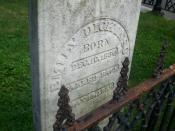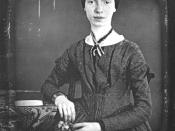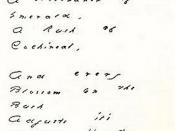If one traces Dickinson's life through her themes and poetry, one can see a repetition between two major themes, which are death, and religion. Theses themes develop such interest to the reader because she broke away from traditional forms of writing and wrote with an intense energy and complexity. While examining her life some, and reading "Safe in Their Alabaster Chambers" and "Because I Could Not Stop for Death" in a certain light, one can see an obvious autobiographical connection.
The themes that Emily Dickinson develops throughout her writing were based one way or another on the same aspect of her upbringing. The themes that were most influential are death and religion. During her childhood, life in Amherst was based strongly upon religion and Puritan values. Her family had become Christians and she alone decided to rebel against that and reject the church. This theme of religion along with death was expressed in her poem "Safe in Their Alabaster Chambers", lines 1-5
Safe in their Alabaster Chambers,
Untouched by morning,
And untouched by noon,
Lie the meek members of the resurrection,
Rafter of Satin, and Roof of Stone!
In the first stanza, I will begin with the word "safe" which can mean safe from the suffering.
She suffered from kidney disease perhaps associated with hypertension. It could also mean that once your dead; you will be "safe" from society. "Alabaster" has two meanings: alabaster is expensive and beautiful; it is also cold and unfeeling. "Chambers" begins the metaphor of the tomb being a home and the dead being asleep. "Rafter" represents the coffin, which is lined in satin. " Roof of Stone" is the tomb itself because it is made of stone. Religion is expressed by the word "resurrection". Resurrection means a new life, and Dickinson probably...


